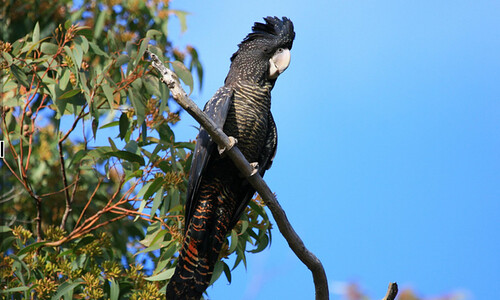Researchers in Western Australia are crowdsourcing population surveys about black cockatoos in an effort to save two rare species.
BirdLife WA received $255,000 from the West Australian government’s Lotterywest fund on Monday to conduct population surveys of the Baudin’s and forest red-tailed cockatoos.
Dr Jessica Lee, threatened black cockatoo project officer at BirdLife, said both species were endemic to the forests of south-western Australia, stretching from Bunbury to Albany, and their large range made it difficult to get an accurate count.
She aims to recruit up to 1,000 volunteers to survey the black cockatoo populations in their local area to build up an estimate of the surviving population.
“The idea is to develop a volunteer base who are able to go out and survey the birds on their own property in their own time to give us a snapshot of the birds that are there,” she said.
They will also support a netting trial in an attempt to reduce the “conflict” between orchardists and the Baudin’s cockatoo, which tends to snack on fruit trees.
Lee said the research project is similar to one being run to monitor the Carnaby’s cockatoos, WA’s other endemic black cockatoo species.
Carnaby’s cockatoos range from Esperance to Geraldton and are listed as endangered. They have been the target of conservation campaigns for the past decade.
But Lee said Baudin’s or long-billed black cockatoos, which are also listed as endangered, and forest red-tailed cockatoos, which are listed as vulnerable, could be under greater threat.
“We estimate there’s between 10,000 and 40,000 Carnaby’s cockatoos in the wild,” she said. “The numbers for the forest red-tailed and long-billed black cockatoos are about 15,000 each.”
Lee said monitoring of Carnaby’s cockatoos showed the population declining by a rate of 15% a year, mainly due to habitat loss.
“That means in the next two decades or so, if the rate were to continue, we would see a total collapse in population,” she said.
“If it’s that bad for a bird like Carnaby’s, where all the work has been done in the past decade, then it’s not hard to imagine that for a bird like the forest cockatoos it would be worse.”
WA environment minister Albert Jacob said black cockatoos were “one of the most iconic species within the only globally-recognised biodiversity hotspot here within [Australia’s south-west forest region]”.
He said the money would fund a two-year research project to support the government’s black cockatoo recovery plans. The Barnett government has spent more than $9m on black cockatoo conservation since 2008.
Lee said she hoped getting the local community involved in surveying the birds would make them invested in the species’ survival.
“Black cockatoos are really a flagship species,” she said. “By protecting black cockatoos you protect everything else that comes beneath them.”
